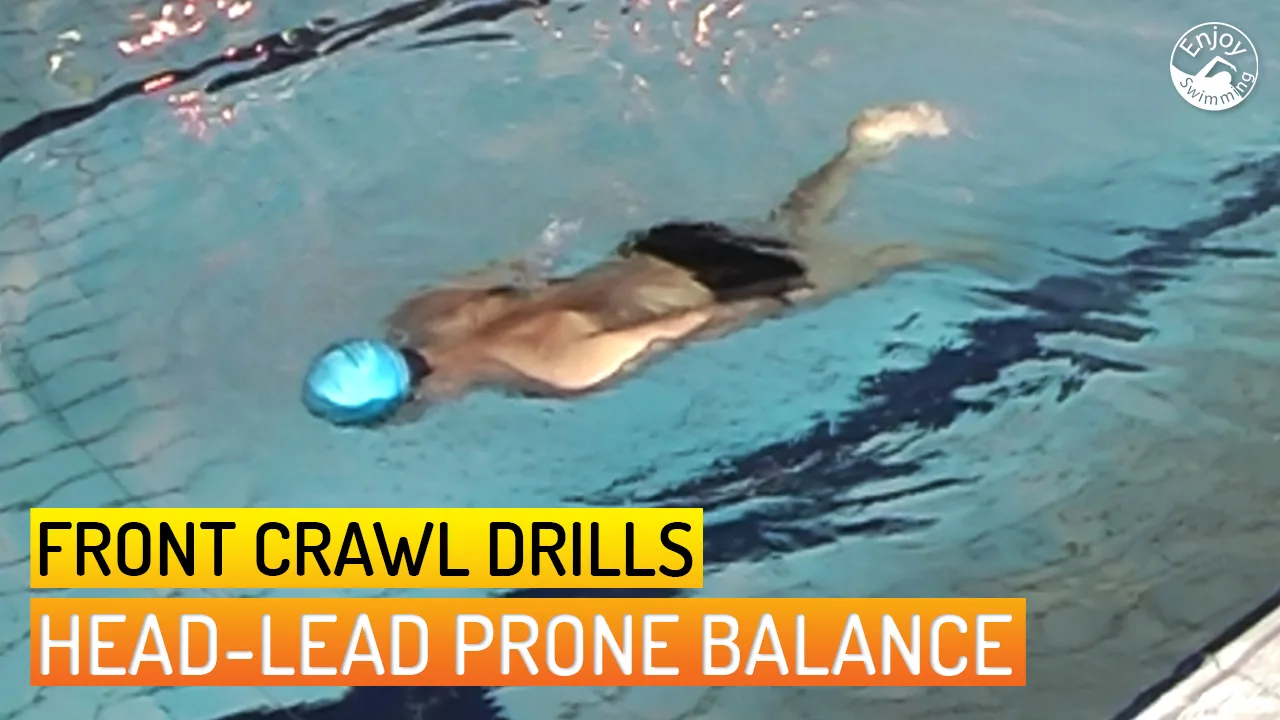Head-lead prone balance is one of the foundational swimming drills for the front crawl stroke.
It lets you practice balance in the water in the prone position.
You will instinctively know how to prevent your hips and legs from sinking in the water once you have mastered this drill.

Video of this Swimming Drill
The following video shows how to perform this drill:
Instructions
1) Push yourself off the wall in the prone position. Keep your head in line with your body and your arms at your sides.
2) Start kicking with a relaxed flutter kick.
3) If you notice that your hips and legs are sinking despite the kicking, try the following: push your upper body down in the water to compensate for your sinking legs.
However, your head and upper body should remain in line. Also, do not press your upper body down too much, but only to the point where you return to a horizontal position.
4) You should notice that your body behaves like a seesaw and your hips and legs come back up without effort. This is the main lesson of this exercise.
5) When you need to breathe, look forward and up until your mouth clears the water, and take a quick breath. You will notice that your hips and legs sink.
6) Immediately bring your head back in line with the rest of your body, and push your upper body down as explained above to compensate and get your body back to horizontal.
7) When you push your upper body down in this way to get your hips and legs up in the water, it is sometimes referred to as pressing the buoy or pressing the T.
Additional Tips
Here are a few more tips for practicing this swimming drill:
1) If your kick is weak, you can also use swim fins. Just make sure that you compensate for the sinking of your hips and legs not by kicking harder but by pushing your upper body down.
2) Do not overdo this exercise, as lifting your head to inhale can strain your neck. Once you have learned how to push your buoy to keep your hips and legs up, move on to the next exercise.
3) A tip for sinkers from Frank, one of our readers: to bring your hips/legs in balance with your shoulders, consciously engage your lower back muscles and also do dry land exercises to strengthen those lower back muscles.
Learning Path for the Front Crawl
Below is an overview of our series of articles on learning the front crawl. Each article in this series contains one or more drills that have to be mastered. The current article is highlighted:
Once you have gone through all the steps of this learning path, you should be able to swim front crawl without any problems.
Good luck!

Francine
Sunday 17th of April 2022
Sinking legs no buoyancy on the lower half of body
Stefan
Monday 11th of June 2018
I had a problem with this exercise.
My experience is that after inhaling, it is better to hold your breath while you obtain balance and the chest is higher. Then you can start to exhale.
Does anyone have the same experience?
Maria Verrecchia
Wednesday 14th of October 2020
Hi Stefan, at last a Forum (thanks to Christophe, where I can find others with similar swimming experiences. Yes, I totally agree, and it makes sense, as the lungs fill with air, optimum buoyancy and the moment to at least ‘feel’ what a prone flutter kick is like before dropping. It is hard to raise the chin after that to inhale and that’s when I tense up, so I put in a pretty wide sweep, almost breaststroke for breath before returning to horizontal position, but I am 65, and two years into learning. Maria, Scotland.
Omo
Tuesday 5th of December 2017
In the video, the swimmer doesn't seem to be exhaling while the head is submerged. I only see bubbles right before the head is lifted to inhale.
Should the breath be held while the head is submerged during this drill?
Christophe
Tuesday 5th of December 2017
Good catch!
It's been a few years since I made the video. Ideally, you should exhale a bit all the time.
I didn't do it in this video though, I don't know why, maybe because I was a bit tense because I was being filmed?
Mukul
Thursday 1st of June 2017
I am not able to breathe at the right moment when I take out my neck and my body totally sinks in the water. What should I do ?
Joe
Wednesday 19th of July 2017
If needed, you can give your hands a little sweep (like the sculling drill), but keep them at your side.
This should provide a little little rigidity and slight upwards propulsion sufficient to breathe until you become strong enough to do this drill without it
Christophe
Sunday 11th of June 2017
It is a question of practice and persistence. Doing the drills from this web site helps too :-)